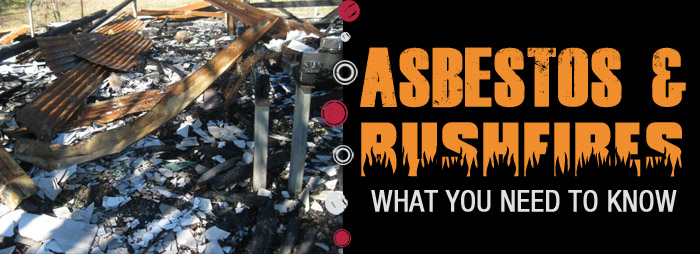
Homes, commercial and non-residential structures burnt in bushfires can create potential health and safety hazards in the remaining rubble and ash.
During bushfires, air quality is also diminished due to airborne ash and smoke which can also contain asbestos fibres if homes and other buildings and structures containing asbestos are damaged causing fibres to become airborne.
With Australia being among the highest consumerS of asbestos-containing materials in the world, during this current bushfire crisis, it’s vital that those living in regions that are affected are aware that asbestos may cause an additional risk to health and take suitable precautions.
Precautions include wearing PPE (Personal Protective Equipment) including a suitable P2 Mask. However, a respirator is preferred as well as wearing disposable coveralls, shoe covers etc. that are disposed of in accordance with regulations. A list of PPE, instructions on and how to wear it and dispose of it can be found here or Download the PDF Fact Sheet.
Quick Links & Find Out More
- FACT SHEET 3: SAFE PRACTICES FOR RURAL & REGIONAL HOMEOWNERS & FARMERS
- FACT SHEET 4: PPE & RPE This fact Sheet provides information about Respiratory Protective Equipment (RPE) and Personal Protective Equipment (PPE), how to use it correctly and effectively and provides information about decontamination.
- TEMPLATES: For various asbestos management templates visit our Fact Sheet page.
- Naturally Occurring Asbestos
- SAFEWORK NSW: PROPERTY HAZARDS FOLLOWING A BUSHFIRE
- Contact your local council to find a landfill site that may lawfully receive asbestos waste in your area.
- To locate your closest asbestos disposal facility visit the Asbestos Safety & Eradication Agency’s disposal database.
- In NSW contact the 1800 Asbestos Hotline (1800 272 378) providing NSW residents with a central point of contact for asbestos inquiries.
- For more information on how to manage asbestos debris on your property safely following a bushfire, visit Resilience NSW or the equivalent in your state or territory.
Why does asbestos pose a risk during and after bushfires?
Asbestos dust and fibres have the potential to present a health risk during and after a fire if not properly managed. Asbestos fibres may be present in the dust and ash and may pose a risk to those disturbing the dust and ash if inhaled while searching for their lost belongings.
Homes and other structures that were built or refurbished prior to 1990 that are burnt during bushfires may cause the asbestos-containing materials to be disturbed or become friable and tiny fibres become airborne.
If fibres become airborne and can be inhaled, they can pose a risk to human health.
Asbestos may be in many forms including flat or corrugated sheets (fibro) used for walls, ceilings, roofing or in products such as pipes, electrical conduit, eaves, wall and floor tiles and other structures including garages and garden sheds. For detailed information access the Asbestos Products Database.
In coastal regions, often “weekenders or shacks” were constructed from flat and corrugated (fibro) sheeting.
In rural and regional areas, in addition to homes, fences, storage sheds, chook sheds, out houses and stock sheds may have been constructed from asbestos. Download the Fact Sheet: FS3: SAFE PRACTICES FOR RURAL & REGIONAL HOMEOWNERS & FARMERS
Naturally Occurring Asbestos (NOA) may also pose a risk in rural and regional areas if disturbed and fibres can be inhaled.
In commercial and non-residential properties asbestos continued to be used in multiple locations prior to 31 December 2003. TYPES OF COMMERCIAL & NON-RESIDENTIAL PROPERTIES MAY INCLUDE ANY STRUCTURE THAT IS NOT PRIVATE DWELLING. For detailed information on safe management of Asbestos in Commercial and Non-Residential properties download the handbook:
It is generally considered:
- Fire damaged asbestos structures do not generate significant levels of asbestos fibres in the air unless disturbed.
- It is low risk to walk around or near asbestos damaged structures. However risks can increase when the material is disturbed and fibres become airborne and can be inhaled.
- Fibres that become airborne can also contaminate clothing and equipment.
Some key facts about asbestos and bushfires:
- Asbestos dust and fibres have the potential to present a health risk during and after a fire if not properly managed.
- Asbestos fibres may be present in the dust and ash and may pose a risk to those disturbing the dust and ash if inhaled while searching for their lost belongings.
- Depending on the extent of the fire damage, the asbestos present can be classified as either friable (can be easily crumbled), or non-friable.
- Asbestos sheets that are severely damaged or reduced to ash are likely to be friable.
- Asbestos that is intact or has suffered smoke damage is likely to be classified as non-friable.
What do you do if your property has been damaged by bushfire?
- DO NOT enter your property until you are advised that it is safe to do so by emergency services, utilities companies or your council.
- Electrical hazards could exist such as live power lines that may be down or active solar panels.
- Buildings and other structures may be unstable to enter or walk over.
- Be aware that hot, smouldering coals and other potentially hazardous materials may be hidden under the rubble.
- Building rubble should not be buried as it may contain hazardous materials including asbestos.
- Don’t spread ash around your property, particularly if asbestos-containing materials were used in your home or other structures, or CCA-treated timber was burnt.
- Moisten the ash with water to minimise dust and keep damp but DO NOT USE HIGH PRESSURE WATER SPRAYS
What to do to reduce the risk of the asbestos fibres becoming airborne until the site is cleaned up.
- Continually dampen down the damaged materials so as not to cause dust.
- The materials may be sprayed with polyvinyl acetate (PVA), or a similar sealant to bind the materials to prevent dust (further reapplication requirements need to be monitored).
- IMPORTANT: Dust suppression should not be so great that it causes runoff into nearby drains and waterways.
- Asbestos waste can only be accepted at some landfill facilities. Contact your local council to find your nearest lawful waste facility and to learn more about the notification and packaging of asbestos.
What precautionary measures are recommended during the clean-up of fire damaged structures containing asbestos?
- Erect Warning signs to discourage people from entering the site.
- Avoid unnecessary entry, particularly entry by children.
- Conduct a site assessment to identify asbestos. This should be undertaken by a licensed asbestos assessor or occupational hygienist. In some cases, emergency services may undertake this role in an emergency situation.
- Asbestos debris should be kept wet or sprayed with PVA, or a similar sealant, to suppress the release of fibres until the material is safely removed. DO NOT USE HIGH PRESSURE SPRAYS.
- Access to the immediate site must be limited to those involved in the clean-up. They are required to wear appropriate personal protective equipment (PPE including a suitable type P2 respirator and disposable coveralls). All personal protective equipment must be disposed of as asbestos waste once the clean-up is completed.
- Asbestos clean-up and removal should be conducted by a licensed asbestos removalist.
- Asbestos waste, including fibro, should be disposed of as soon as possible. The materials should be kept damp until they can be double wrapped in heavy duty (0.2mm) plastic, sealed with tape and labelled as asbestos waste.
For more information on Property Hazards Following a Bushfire, visit SafeWork NSW
Important Safety Facts To Know When Working With Asbestos
- There are a number of safety precautions you will need to undertake including wearing approved protective clothing, the correct mask (not all masks are safe) or breathing apparatus. Download Fact Sheet 1 or 2 for detailed instructions on what you need.
- For important information about working with asbestos read Safe Work Australia’s Model Code of Practice: How to safely remove asbestos July 2020.
Remember: If the asbestos is in powder form or can be crumbled, pulverised or reduced to powder by hand pressure when dry, it must be removed by an asbestos removal contractor with a friable asbestos licence.
Share this information on:

